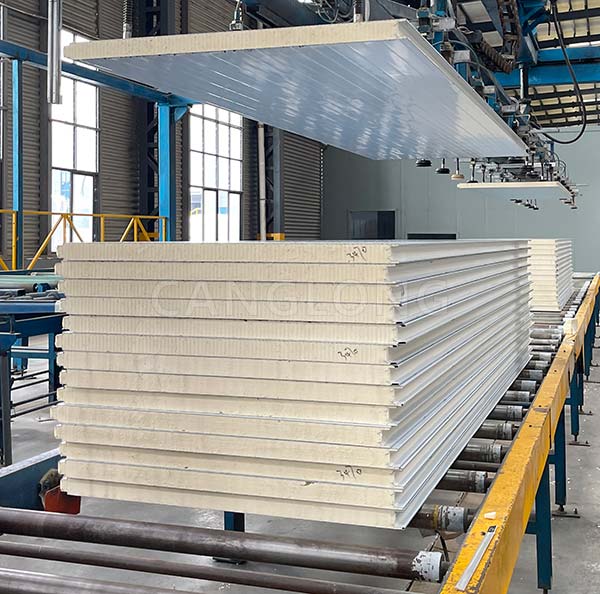Manufacturing and design features of PU sandwich panels
Manufacturing Process of PU Sandwich Panels
PU sandwich panels (polyurethane sandwich panels) are a composite material widely used in construction, refrigeration, industry and commerce. It consists of two layers of outer materials and a polyurethane foam core material in the middle, which has excellent thermal insulation performance and structural strength. The following is the manufacturing process of PU sandwich panels.
1. Raw material preparation
- Outer material: Galvanized steel sheet, stainless steel or aluminum alloy is usually used. Depending on specific needs, the outer layer can be a flat plate or embossed plate.
- Core material: Polyurethane foam is the core material with excellent thermal insulation performance and lightweight characteristics.
2. Raw material processing
- Outer material processing: The outer material needs to be cleaned, degreased and coated to improve adhesion with polyurethane.
- Polyurethane preparation: The preparation of polyurethane foam involves mixing isocyanate and polyether polyol to produce foam material. During this process, catalysts, foaming agents and other additives are also added to control the density and hardness of the foam.
3. Sandwich panel molding
- Gluing: Glue the treated outer layer material and polyurethane foam to ensure good adhesion.
- Foaming molding: Pour the mixed polyurethane liquid between the outer layer materials, and after a certain period of foaming reaction, form solid polyurethane foam.
- Pressing: During the foaming process, use a press to press the outer layer material to ensure uniform filling of the foam and improve the density.
4. Cutting and trimming
- Cutting molding: After the polyurethane is completely cured, cut it into sandwich panels of the required size according to the design requirements.
- Edge treatment: Treat the edges after cutting to ensure flatness and remove burrs to avoid problems during installation.
5. Quality inspection
Performance testing: A series of performance tests are carried out on the finished product, including thermal insulation performance, compressive strength, tear strength, etc., to ensure that the product meets relevant standards and customer requirements.
Design features
PU sandwich panels are widely used in the construction field due to their excellent performance and flexible design. Its design features mainly include the following aspects:
1. Excellent thermal insulation performance
Polyurethane foam has a low thermal conductivity coefficient and can effectively block heat transfer, thus providing excellent thermal insulation. This makes PU sandwich panels very suitable for cold storage and insulation buildings.
2. Lightweight and high strength
Due to the lightweight characteristics of polyurethane, PU sandwich panels have a lower deadweight than traditional concrete or masonry materials, reducing the foundation burden while ensuring the strength of the structure.
3. Good fire resistance
Modern PU sandwich panels usually add fireproof materials and have certain fireproof properties, which can effectively delay the spread of fire and improve the safety of buildings.
4. Corrosion resistance
Outer materials such as galvanized steel plates or aluminum alloys have good corrosion resistance and are suitable for use in various harsh environments, extending their service life.
5. Flexible design and construction
PU sandwich panels can be customized according to different building needs, and the size, color, surface treatment, etc. can be flexibly adjusted to adapt to various architectural styles. In addition, due to its lightness and easy installation characteristics, it can significantly shorten the construction period.
6. Environmental protection
The manufacturing process of polyurethane materials is relatively environmentally friendly, and it can reduce energy consumption during use, which meets the sustainable development requirements of modern buildings.

Conclusion
PU sandwich panels have become an indispensable material in modern buildings with their excellent thermal insulation performance, light weight, high strength, corrosion resistance and flexible design features. Through reasonable manufacturing processes and strict quality control, PU sandwich panels not only meet the functional requirements of buildings, but also make positive contributions to energy conservation and environmental protection. With the continuous advancement of technology, the application fields and designs of PU sandwich panels will become more diversified, promoting the development of the construction industry.
